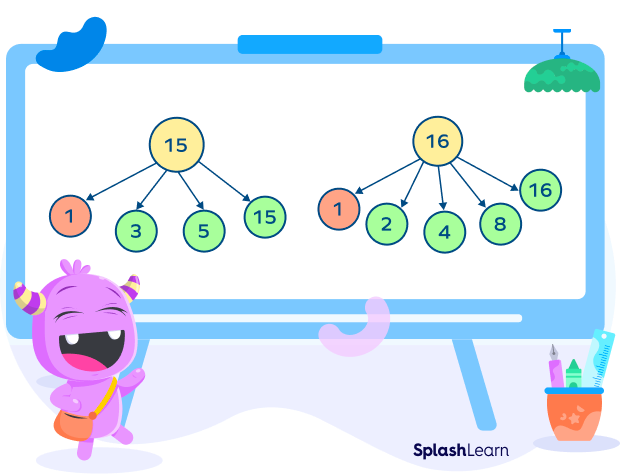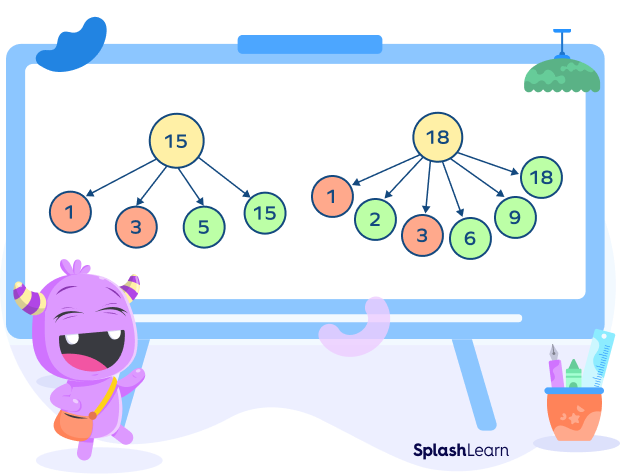Relatively Prime Numbers: Introduction
We know that a prime number is a number that has only two factors, 1 and the number itself. So, what are relatively prime numbers? What does relatively prime mean? Numbers that have 1 as the only common factor are said to be relatively prime. Relatively prime numbers need not be prime numbers!
Recommended Games
What are Relatively Prime Numbers?
When two numbers have no common factors other than 1, they are said to be relatively prime. In other words, no number other than 1 can divide them both exactly (without any remainder).
Relatively prime numbers are also called “coprime numbers” or “mutually prime numbers.”
Two numbers m and n are said to be relatively prime if GCF(a,b) $= 1$.
In that case, the pair (a, b) is called a relatively prime pair.
Example: 5, 7 are relatively prime since GCF $(5,7) = 1$
The two numbers that are relatively prime may be prime or composite. Two composite numbers can also be relatively prime. But the common factor of both the numbers is none other than “1.”
Consider an example. What are the common factors between 9 and 25?
The only common factor of 9 and 25 is 1.
Thus, 9 and 25 are relatively prime.
Note that 9 and 25 are composite numbers (not prime numbers!).
Example 1: 15 and 16

Factors of 15 are 1, 3, 5 and 15.
Factors of 16 are 1, 2, 4, 8 and 16.
Common factor of 15 and 16 is only 1.
Hence, 15 and 16 are relatively prime numbers. However, 15 and 16 both are composite numbers.
Example 2: 15 and 18
Factors of 15 are 1, 3, 5 and 15.
Factors of 18 are 1, 2, 3, 6, 9, 18.

Common factors of 15 are 1 and 3.
Hence, 15 and 18 are not relatively prime numbers.
Recommended Worksheets
How to Find Relatively Prime Numbers
To find whether two numbers are relatively prime or not, we find the Highest Common Factor (HCF) (or Greatest Common Divisor GCD) of the given numbers.
If the HCF is 1, then the two numbers are said to be relatively primes.
To find the HCF (Highest Common Factor) of two numbers, we first list all the factors and then identify the highest common factor out of those.
Example 1: 11 and 12
The factors of 11 are 1 and 11.
The factors of 12 are 1, 2, 3, 4, 6 and 12.
Here, 1 is the only common factor of 11 and 12.
HCF of $(11, 12) = 1,$
Thus, (11, 12) is relatively prime because only 1 is a common factor.
Example 2: 14 and 16
The factors of 14 are 1, 2, 7, and 14.
The factors of 16 are 1, 2, 4, 8 and 16
Here, 1 and 2 are the common factors of 14 and 16.
HCF $(14, 16) = 1 \times 2 = 2$
Thus, (14, 16) is not relatively prime.
Properties of Relatively Prime Numbers
Here are a few properties of relatively prime numbers. You can easily form a “list of relatively prime numbers” using these properties.
- Any two consecutive integers are always relatively prime.
Example: (2, 3) ; (11, 12) ; (21, 22) ; (100, 101) and so on.
- Any two prime numbers are relatively prime to each other. As every prime number has only two factors 1 and the number itself, the only common factor of two prime numbers will be 1.
Example: 11 and 13 are two prime numbers. Factors of 11 are 1, 11, and factors of 13 are 1, 13. The only common factor is 1 and hence they are relatively prime.
- If two numbers have 0 and 5 at ones place, then they are not relatively prime to each other.
For example: 10 and 15 are not relatively prime since their HCF is 5 (or divisible by 5).
- The sum of two relatively prime numbers is always relatively prime with their product.
For example, 4 and 5 are relatively prime numbers. Here, $4 + 5 = 9$ is relatively prime with $4 \times 5 = 20$. As the only common factor of 9 and 20 is 1.
- The Least Common Multiple (LCM) of two relatively prime numbers is always equal to their product.
For example: LCM of 4 and 5 (relatively prime numbers) $= 20$.
- If n is a prime number, then all integers less than or equal to n are relatively prime to n.
- If a and b are two relatively prime numbers, then $a + b$ is relatively prime to $a \times b$.
- If a and b are relatively prime numbers, then HCF $(a, b) = 1$ and LCM $(a, b) = a \times b$.
Fun Facts!
- 1 is relatively prime with every number even itself.
- 0 and 1 are relatively prime numbers, as the common factor is 1.
- 0 is not relatively prime with any other integer except 1. It is divisible by any integer.
- Any two prime numbers are relatively prime.
- Any two consecutive numbers are relatively prime.
- A prime number is relatively prime with any other number if the other number is not the multiple of the given prime number.
- Two even numbers can never form a relatively prime pair as all the even numbers have a common factor as 2.
- Relatively prime numbers don’t need to be prime numbers. For example, two composite numbers 12 and 35 are relatively prime numbers because their HCF is 1.
- Relatively Prime numbers are also called “coprime” numbers or “mutually prime” numbers.
- The Least Common Multiple (LCM) of two relatively prime numbers is always equal to their product.
Conclusion
In this article, we learned that two integers are relatively prime if the common factor or the Highest Common Factor (HCF) of the two numbers is “1.” So two consecutives integers are relatively prime. Relatively prime numbers don’t need to be prime numbers. Two composite numbers can be relatively prime.
Solved Examples
1. Check whether 11 and 21 are relatively prime/co-prime numbers.
Solution:
Factors of 11 are 1 and 11.
Factors of 21 are 1, 3, 7 and 21.
They have only 1 as a common factor. Thus, 11 and 21 are relatively prime/co-prime numbers.
2. Check whether 13 and 23 are relatively prime/co-prime numbers.
Solution:
13 and 23 both are prime numbers.
From the property of relatively prime numbers, numbers 13 and 23 are relatively prime numbers.
Alternatively, since 13 is a prime number, its factors are 1 and 13 only.
And 23 is also a prime number, so its factors are 1 and 23 only.
They have only 1 as a common factor, so 13 and 23 are relatively prime/co-prime numbers.
3. Check whether 155 and 290 are relatively prime/co-prime numbers.
Solution:
The given two numbers are 155 and 290.
155 and 290 are divisible by 5, as the last digit of the numbers are 5 and 0 respectively.
From the properties of relatively prime numbers, 155 and 290 are not relatively prime.
Alternatively,
$155 = 1 \times 5 \times 31$
$290 = 1 \times 2 \times 5 \times 29$
HCF $(155, 290) = 1 \times 5 = 5 \neq 1$
Therefore, 155 and 290 are not relatively prime.
4. Check whether 200 and 201 are relatively prime/co-prime numbers.
Solution:
Numbers 200 and 201 are consecutive integers.
Hence, 200 and 201 are relatively prime/co-prime numbers.
5. If a and b are two relatively prime numbers whose lowest common multiple is 195. If a = 15, what is the value of b?
Solution:
The Least Common Multiple (LCM) of two relatively prime numbers is always equal to their product.
So, $a \times b = 195$
$15 \times b = 195$
$b = \frac{195}{15}$
$b = 13$
Practice Problems
Relatively Prime
Which among the following is relatively prime with 16?
Two even numbers can never be relatively prime.
2, 4, 8, and 16 all are even numbers. So, the number relatively prime with 16 is 3.
Which of the following pairs of numbers are relatively prime?
Numbers 11 and 39 have no common factors other than 1. So, 11 and 39 are relatively prime numbers.
If two numbers, a and b, are relatively prime, what is the Highest Common Factor (HCF) of a and b?
Two numbers are relatively prime, when their Highest Common Factor (HCF) is 1. So, the Highest Common Factor (HCF) of a and b is 1.
Which of the following numbers cannot be identified as relatively prime?
Two even numbers can never be relatively prime since they have a common factor 2.
Frequently Asked Questions
Is 0 relatively prime to any number?
The numbers 1 and $-1$ are the only integers coprime to 0.
Are 0 and 1 relatively prime numbers?
Yes, 0 and 1 are relatively prime numbers, as the only common factor of 0 and 1 is 1.
What is the difference between prime numbers and relatively prime numbers?
A prime number is a number that has no factor other than 1 and itself. And relatively prime numbers are those pairs of numbers, whose common factor is 1.
What is the difference between twin prime numbers and relative prime numbers?
A twin prime is a pair of prime numbers, such that the difference between the two prime numbers is 2. Relatively prime numbers can be any pair of numbers whose highest common factor is 1. That means two composite numbers can be coprime numbers if their HCF is 1.
Find all the relative prime numbers to 11.
All numbers from 1 to 11 are relative primes to 11.
Is 1 relatively prime to every number?
Yes, 1 is relatively prime (co-prime) to every number.























